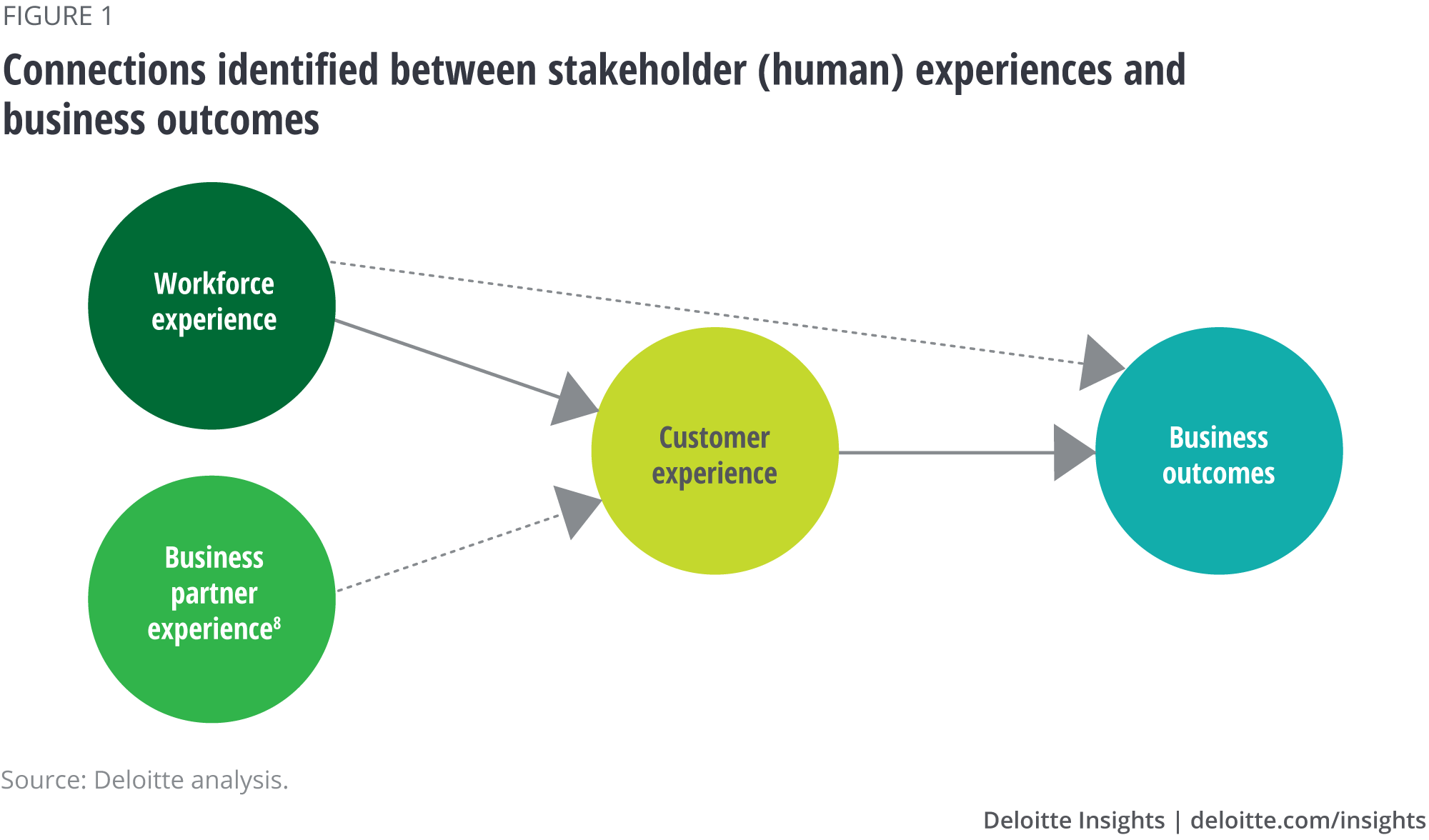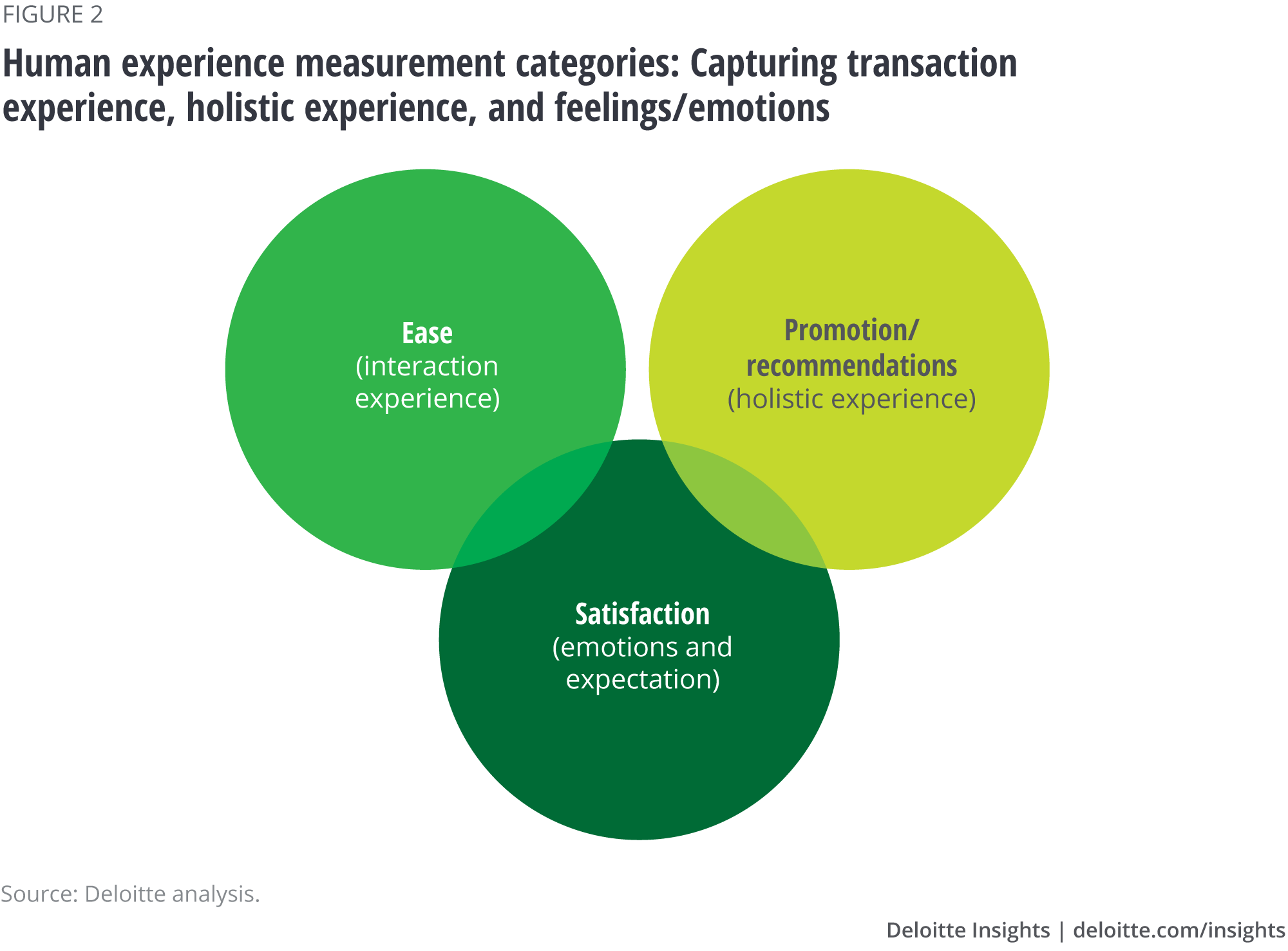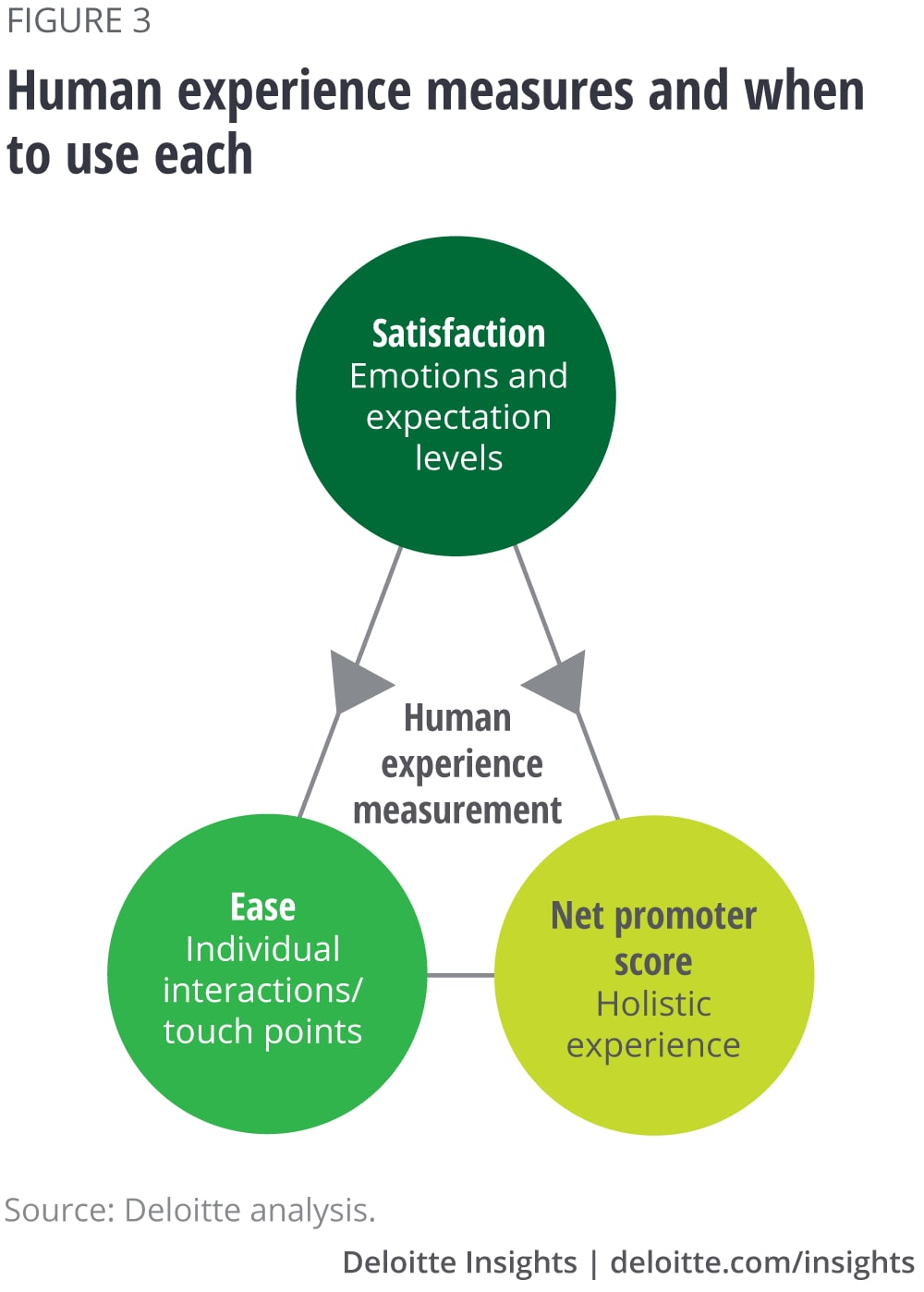
Measuring human relationships and experiences Blurring lines and shifting sands
11 minute read
20 June 2019
 Arthur H. Mazor United States
Arthur H. Mazor United States- Jannine Zucker United States
 Susan K. Hogan United States
Susan K. Hogan United States Hilary Horn United States
Hilary Horn United States
With the lines between enterprises' stakeholders—customers, workers, and partners—blurring rapidly, creating a good human experience could begin with putting in place a holistic strategy to measure this experience.
“It would be wonderful if we could have a common framework that applies across customer, partner, and workforce. If there is a common way to think about 'experience' across all three parts of the ecosystem, this could drive an enterprise’s competitive advantage.”1
Learn more
Browse the Future of work collection
Subscribe to receive related content from Deloitte Insights
Most enterprises have long acknowledged the need to widen their lens beyond the customer experience to include at least two other key stakeholder groups—workers and partners—whose experience can directly or indirectly influence business outcomes2 (see figure 1). The term human experience (HX), in use for over a decade, was coined to encompass these various groups,3 and is now popular in several business sectors, including advertising,4 real estate,5 and marketing and consulting.6

But confining these three sets of stakeholders to their own silos for the purposes of marketing, engagement, and measurement seems no longer an option, as the boundaries between them are blurring. For instance, customers—in both business-to-business and business-to-consumer spaces—have gained more power over the last two decades and are becoming the critical provider of inspiration for many of an enterprise’s new product ideas, driving innovation and serving as both collaborators and buyers. In such a scenario, is the “customer” merely a user of services or an integral part of the enterprise’s services, or perhaps even a member of the workforce?
The same holds true for an enterprise’s “workforce.” In recent years, the relationship between workers and many organizations have changed,8 allowing for a portfolio of different types of company-worker configurations and contracts (full-time, part-time, contract, freelance, gig). The lines are blurring between what constitutes a worker, a business partner, or a customer, and the door between these relationships is no longer closed; it is a revolving one. For instance, an enterprise should consider where former workers go—short term and long term. There is a higher probability than in the past that they will come back to the enterprise in the future as “boomerangs”—and they might also become business partners, customers, or at the very least advocates or detractors of the organization.
The lines are blurring between what constitutes a worker, a business partner, or a customer, and the door between these relationships is no longer closed; it is a revolving one.
In the case of companies in the sharing economy, such as ridesharing services and online home rentals, the lines tend to be even less distinct. Is a rideshare driver or an online home renter-owner an employee, customer, business partner, or a hybrid combination?
Companies have already started exploring ways in which a comprehensive lens can be applied to the human experience to create a journey that mirrors and matches consumer experience.9 Digital is making it easier to create these experiences. But to design meaningful experiences we should understand stakeholders’ requirements, experiences, and behaviors, all backed by adequate data. In today’s world, data is everywhere, and companies should and are tapping into it to inform their strategies. The unstructured data that is freely available as digital exhaust, metrics on stakeholder preferences, satisfaction levels, and their likelihood of recommending a particular product or service to others, can provide a reliable backbone to a company’s strategies and help improve products and services, refine messaging, and inform investments—all of which contribute to the human experience. As Peter Drucker aptly put it, “You can’t manage what you can’t measure.”10
While most enterprises do acknowledge the need to keep a finger on the pulse of various stakeholder groups, tools to measure this “experience” across the three groups in a continuous and consistent manner are limited in number and scope. While enterprises have created myriad measures to understand and manage relationships with both customers and their workforce to improve customer and workforce relationships and experiences, the approach is generally a siloed one: Typically, customer measures have been driven by an organization’s marketing arm, and the workforce measures by the talent arm. Siloed measurement strategies may have served enterprises well in the past, but, given the blurring boundaries between stakeholder groups and the way in which stakeholder interactions with the enterprise are evolving, this lens seems no longer appropriate or sufficient to keep track of and manage relationships.
With the aim of incorporating this comprehensive lens into the continual relationship tracking and measurement that enterprises should put in place, the deployment of three key measurement categories should be considered—ease, recommendation likelihood, and satisfaction—at key moments in a stakeholder’s journey.
In rolling out this common human relationship–measurement strategy, organizations should also take into consideration collection timing, digital, communications, and cultural factors.
Three key measurement categories
“Understanding, managing, tracking, and improving ‘human experiences’ really should be more integrated—after all, workforce experiences are or should be driven by customer and partner experiences.”
There are three measurement categories that can provide insight into stakeholder loyalty or retention risk:
- “Ease” (or lack of effort or complexity) score;
- Recommendation or promotion likelihood; and
- Satisfaction.11
In addition to loyalty, ease (or low friction effort) measures can help pinpoint areas or processes in specific need of improvement during the human journey. Workforce complexity has also been linked to customer experience ratings and enterprise profitability.12 Promotion or recommendation likelihood can provide a more holistic read than ease measures, and beyond identifying human retention risk likelihood, also provides an indication of how an enterprise stacks up against competitors (or the competitive landscape).13 Rounding out the categories is satisfaction, which is linked with customer retention as well as share of wallet, 14 and can also provide insight into the individual stakeholder’s feelings or emotions.
These three measurement categories cover trails blazed by leading enterprises in consumer marketing that have long understood the power of simplifying consumers’ experiences; garnering recommendations from trusted friends, family, and coworkers; and creating satisfaction or delight. The increasing convergence of customers, partners, and workers creates common ground in these stakeholders’ expectations for all of their human experiences and, as a result, tighter connection in the measurement of experience regardless of which hat a stakeholder may be wearing at any given moment in their experience with an enterprise.
To inform the timing of measurement, we focus on the moments that matter within a stakeholder’s journey that have the potential to make a measurable impact in not just the specific experience, but also the overall relationship. This focus on moments that matter is a strategy we have employed within Deloitte to, inform, guide, and improve our external (client) and internal (workforce colleague) interactions and subsequently, overall relationships.15 These moments are various interactions—or touch points—in a stakeholder’s journey that can make a measurable impact. In the traditional siloed setup, for customers, these moments encompass aspects of the prepurchase search process; the purchase experience, such as the transaction and checkout process; and the postpurchase experience, such as product utilization, customer service inquiries, product disposal, trade-in, or upgrade options. For workers, moments could include the recruiting and hiring process, and once hired, the promotion and rewards process, flexible work opportunities, recognition opportunities, and the postemployment experience such as the separation process and retirement benefits. For business partners, moments that matter might include contract negotiations, profit-sharing opportunities, and fair-trade policies. To get an exact measure of the human experience, enterprises should deploy select measurements at appropriate moments.
In the human experience journey, we could arrange these moments that matter on the spectrum from the preengagement phase—when a company is still trying to reach out to and engage with potential stakeholders—through the transaction/journey, right into the moments that bring the interaction to an end. For each of the selected three metrics to have maximum impact, it is important to deploy them at the right touch points.

“It would be great to bring CMOs and CHROs together for not only a discussion, but creation of a common measurement platform.”
Ease (low effort/low complexity)
Ease of interaction can be measured at any of the key moments that matter in the human experience journey. Common questions could include: How much effort was required in making your reservation? Please rate your agreement with the following statement: “The website made it easy to find the information I was looking for.” In the customer experience arena, these scores have not only been found to be an indicator of customer loyalty—more so than satisfaction scores16—but they also provide actionable insights into which parts of the customer experience can be improved.17
In the workforce experience arena, a similar, perhaps parallel, measure—work complexity—has gained in popularity. A recent study measured work complexity by looking at such factors as ability and ease of connecting virtually and using and gaining access to technologies needed for work.18 This has often been found, along with a workplace’s behavioral norms, to influence the worker experience, which in turn, can influence an enterprise’s profitability, innovation likelihood, and customer experience measures.19 For business partners, depending on the nature of their relationship, this measure could be adapted to measure the ease of doing business during critical aspects of the partner relationship, such as contract negotiations and collaboration for execution and delivery. Where these roles are not quite so well-defined, enterprises can first identify key stakeholders and significant interactions and then deploy this metric at the key moments.
However, while ease measures are good for surfacing issues with process or during specific experiences, their transactional nature can limit their ability to provide an end-to-end picture of the various aspects of the human experience journey. A more holistic measure, specifically the net promoter score (NPS), should be considered.
Promotion/recommendation likelihood
NPS, which indicates a person’s willingness to recommend a product, service, or experience to another potential user is a common measure to understand stakeholders’ holistic experience with an enterprise. It generally comes from responses to a single question on a 10-point scale: How likely are you to recommend a company’s product or service?20 Given its holistic nature, this measure should be collected at less frequent intervals than the ease measure—perhaps, once every six or 12 months, or at the midpoint and end of a contract or performance period.
For client and partner stakeholders, the NPS measure helps identify customers who are a retention risk as well as those who could be enterprise advocates. It’s also an easy way to benchmark an organization against a competitor.21 Similarly, a two-pronged variant of the NPS measure, referred to as the eNPS (employee net promoter score) measures the holistic worker experience—particularly with regard to worker engagement and loyalty. Specifically, the eNPS measure captures a worker’s likelihood of recommending their employer’s products and services to others, and also their likelihood of recommending their employer as a place to work to others.22
But while the NPS, or a derivative, can be of value in getting a read on stakeholder loyalty and how the enterprise stacks up against competitors, it falls short when it comes to understanding stakeholder’s emotional connection,23 or feelings in general. Also, the verdict is still out as to how much this rating is truly tied to business outcomes.24 Hence the importance of measuring satisfaction.
Satisfaction
Satisfaction scores, one of the most common measures used,25 allow enterprises to get detailed information on various aspects of the human experience, from a specific transaction to their perception of an end-to-end journey. And, while other measures may give more of an objective read, satisfaction measures enable enterprises to tap into the emotions of key stakeholders. They also have the advantage of being clearly understood by respondents and easy to communicate to leadership.26 Research has also shown that in the customer domain, there is a connection between satisfaction and customer retention27 and share of wallet.28

As illustrated in figure 3, satisfaction is a powerful coupling measure and adds a more emotional element to ease and NPS measures. That is, when collected concurrent with the more objective reads of ease and recommendation likelihood, it can serve as an emotional gauge, providing insights into the stakeholder feelings. Satisfaction measures should be collected with both ease measures during interactions and with the recommendation likelihood measures (for example, at set longer intervals such as every six months or at mid and end points during a contractual and performance period).
Figure 4 summarizes three key measurement categories for each of the three stakeholder groups, as well as when to collect this data.

Getting from here to there: Guidelines for executing a holistic human measurement strategy
In an effort to provide a holistic experience by tracking, measuring, and managing human relationships through all their stages and, more importantly, achieve the goal of developing long-term intimate relationships with enterprise stakeholders throughout their lifetime, the following guidelines should be considered for executing a comprehensive human relationship measurement strategy:
Break down internal silos. The goal behind a common measurement system is to track and improve all stakeholders’ experiences over the lifetime of their relationships with an enterprise and, perhaps more importantly, develop a more intimate, continuous, richer relationship with each individual. To do this, an enterprise must abandon its own siloed structure and operations. Chief marketing officers and chief human resource officers, along with chief operations officers and chief information officers, should collaborate and create a set of common measures that fall within the three categories of ease, promotion, and satisfaction—continuously measuring and taking actions throughout the individual’s relationship with the company. Involving technology leadership is important to enable the seamless collection, reporting, and analysis of these measures, to understand individuals’ experiences as their relationships with the organization evolve.
“While people want human interactions, you can still have lots of positive—and human—interactions without humans involved in every step of the experience.”
Capitalize on and leverage the power of digital. While enterprises certainly should care about human-human interactions, the potential benefits of leveraging technology for the measurement, tracking, and management of human relationships are undeniable. With AI and cognitive technologies, enterprises can have the best of both worlds, as these technologies can make many digital interactions seem uniquely human, both in terms of the interaction interface and the way in which the digital interface is able to relate to people through functions such as remembering and referencing past orders and a suitable communication style. Digital technologies can also help minimize the “effort” and increase the “ease” of an interaction, for instance, by offering a choice among live chat, email and a phone call, automated messages, one-click purchasing, and so on. Digital can and should be exploited to continually improve the human relationship measurement process through facilities such as simple in-the-moment questioning on a person’s preferred device with voice-activated response options. Measures need to be easy and noninvasive, and digital can help with this.
The importance of expectations. As research and market experience suggest, satisfaction is subjective. How pleased or happy an individual is with an experience is largely driven by his/her expectations.30 These expectations can be driven by experiences out of the control of an enterprise, for example, experiences with competitive offerings. Or they can be driven by what an enterprise communicated internally (such as what workers should expect from the firm and how they should behave) and externally (how long delivery should take or how soon a call should be returned). While enterprises cannot control what is offered by the external market, they can derive insights about these from satisfaction scores. One way of offsetting the effect of expectations is setting and communicating expectations about “experience” aspects such as effort and time required and product strength and weaknesses.
“The main thing is to keep the main thing the main thing.”—Stephen Covey
Late educator, businessman, and author Stephen Covey reminds us of the importance of not losing focus: Measurement is—and should remain—a means to an end, not an end in and of itself. While we agree that measures are important and, when appropriately collected, tracked, and analyzed, help manage and improve stakeholder relationships, collecting data should not take precedence over or detract from an interaction. Rather, understanding the needs of stakeholders and nurturing those relationships should remain an enterprises’ priority.31 Thus, while we encourage our readers to embrace these three measurement categories to track and manage relationships with key stakeholders throughout the various twists and turns the relationship may take, there are some relationship moments that might be hard to capture, and that is okay. Sometimes it is worth losing a measurement battle to win the relationship war.
Explore the Future of work
-
2024 Global Human Capital Trends Article8 months ago
-
What is the future of work? Article5 years ago
-
The future of work in technology Article5 years ago
-
The future of work isn’t scary, but it is misunderstood Collection5 years ago
-
What is work? Podcast5 years ago
-
Superminds Article5 years ago











